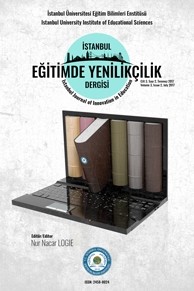OTİZMLİ ÇOCUKLARIN EĞİTİMİ İÇİN MOBİL UYGULAMA
Otizm, Mobil Uygulama, Eğitsel Yazılım, Özel Eğitim, Olay Sıralama
OTİZMLİ ÇOCUKLARIN EĞİTİMİ İÇİN MOBİL UYGULAMA
___
- Bayram, S. (2006, 14 Mayıs), Bilgisayar Destekli Özel Eğitim. Erişim tarihi: 29 Ağustos 2016, http://www.servetbayram.com/otizmce/http/kongre_makale.doc.
- Cafiero, J. M. (2012). Technology supports for individuals with autism spectrum disorders. Journal of Special Education Technology, 27 (1), 64.
- Özdemir, Ş., Akadal, E., Çelik, S., Reis, Z. A. (2013), Uygulama marketlerinin eğitim kategorisi altındaki uygulamalarının incelenmesi. Erişim tarihi: 29 Ağustos 2016, http://ab.org.tr/ab13/bildiri/262.pdf .
- Tohum Otizm Vakfı (2014), Otizm spektrum bozukluğu: şimdi ne olacak?. Erişim tarihi: 29 Ağustos 2016, http://www.tohumotizmportali.org/docs/OSB-simdi-neolacak-PEMBE-KITAPCIK.pdf .
- Tripp, S.D. & Bichelmeyer, B. (1990). Rapid Prototyping: An alternative instructional design strategy. Educational Technology Research and Development, 38(1), 3144.
- Yılmaz, D., Polat, F., Adıgüzel, T. (2014). Otizmli çocuklar için geliştirilen tablet bilgisayar yazılımların eğitsel nitelikleri açısından incelenmesi. Erişim tarihi: 29 Ağustos 2016, https://www.academia.edu/9929465/ Otizmli_Bireyler_i%C3%A7in_Geli%C5%9Ftirilen_Tablet_Bilgisayar_ Yaz%C4%B1l%C4%B1mlar%C4%B1n%C4%B1n_E%C4%9Fitsel_ Nitelikleri_A%C3%A7%C4%B1s%C4%B1ndan_%C4%B0ncelenmesi.
- ISSN: 2458-8024
- Başlangıç: 2015
- Yayıncı: İstanbul Üniversitesi
An Augmented Reality Interface for Choreography Generation
Tafadzwa Joseph DUBE, Gökhan KURT, Gökhan İNCE
MATEMATİK ÖĞRETİMİ İÇİN NOKTA BELİRLEME TEKNİĞİNE DAYALI BİR MOBİL UYGULAMA
Eren Deniz GENÇ, Hilal Nur ISSI, Oktay YILDIZ
OTİZMLİ ÇOCUKLARIN EĞİTİMİ İÇİN MOBİL UYGULAMA
Elif ŞENYÜREK, Deniz YILMAZ, Hatice KÖSE
AUGMENTED REALITY BASED DESKTOP HISTORY LECTURE: WONDERS OF THE WORLD WITH ANIMATED AGENTS
Mert Can ALICI, Erkan BOSTANCI
Yusuf KALINKARA, Metin KAPIDERE
TÜRKİYE’DE NÖROLOJİK REHABİLİTASYON KAPSAMINDA BİR MÜZİK TERAPİ PROJESİNİN GELİŞTİRİLMESİ
Beril Melina DURSUN, Soner AKYEL, Seda ŞEN, Çağla KARACAN, Begüm Çapa TAYYARE, Tuğba GÖKBEL, Yüksel TAŞÖREN, Erbil DURSUN
ARTIRILMIŞ GERÇEKLİK TEKNOLOJİSİNİN VERİTABANI DERSİNDE KULLANIMI
Mehmet ALBAYRAK, Volkan ALTINTAŞ
PROBLÉMATIQUE DE CONSTITUTION D’UNE GRILLE D’ANALYSE DE L’ORAL ÉMOTIONNEL
